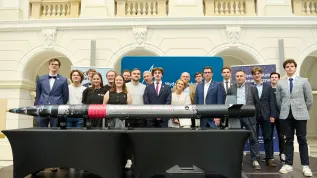
Nearly 86,000 foreigners are now studying in Poland, with more than half coming from from Ukraine and Belarus, says a new report from Poland’s science and higher education data collection agency RAD-on data.
Developed by experts from the National Information Processing Institute (OPI PIB) in collaboration with the Ministry of Education and Science, the agency found that around 36,000 Ukrainians and 11,000 Belarusians are now pursuing full-time study programmes, followed by students from Zimbabwe and Nigeria.
Unlike Poles, however, the foreign students prefer studying at private higher education institutions - 52% of foreigners vs. 30% of Poles in 2021.
In 2021, doctoral schools had 12,000 students. This included 1,400 foreigners, the largest shares of which came from India (18%), Ukraine (11%), and Iran (10%). The most popular doctoral schools included those specialising in engineering, science and natural sciences; they educated over 6,000 students.
RAD-on reports that the number of students in Poland has decreased by 5% over the last five years, while the number of foreign students has increased by 20%.
Dr. Aldona Tomczyńska, Data Science Team Leader at the Laboratory of Databases and Business Analytics at OPI PIB said: “Interestingly, downward trends were observed only at public and church higher education institutions.
“The overall number of students at non-public higher education institutions increased by 27%, while the number of foreign students forged ahead by 40%.”
She added that in 2021, in the Mazowieckie province, there were 108 institutions - more than twice as many as in the Śląskie province, which took second place with 40 institutions. Warsaw alone had 85 institutions, or 20% of all institutions in Poland.
The number of public and church higher education institutions did not change (131 and 17 institutions, respectively, in 2021). The number of non-public institutions decreased from 332 in 2012 to 278 in 2021 (by 16%).
Dr. Tomczyńska said: “This may be a result of the demographic decline: the institutions with poor educational standards have been forced to close down.”
The RAD-on data also show that in 2021, one in ten academic teachers was a professor - 6% of women and 14% of men. The largest group of academics was doctors (47%). Public higher education institutions employed 90% of academic teachers, despite less than 70% of students studying at the same group of institutions.
RAD-on is financed by the Polish Ministry of Education and Science.
The National Information Processing Institute (OPI PIB) builds computer systems and creates software for the public sector and for commercial purposes. It collects, analyses and creates information about the research and development sector.
PAP - Science in Poland, Danuta Starzyńska-Rosiecka
dsr/ joz/ kap/
tr. RL













